Florida Driver Handbook: Pavement Markings
Order now9. Signals, Signs and Pavement Markings
- 9.1. Traffic Control Signals
- 9.2. Pedestrian Signals
- 9.3. Lane Signals
- 9.4. Ramp Signals
- 9.5. Traffic Signs
- 9.6. Pavement Markings
Lines, symbols and words are often painted on a roadway to help direct drivers and control traffic flow. You must know what the different lines and colors mean and obey them as you would traffic signs or signals.
White and yellow lines are used along pavement edges and between lanes to keep vehicles in line. These lines may be solid or broken (long dashes), single or double.
Unless you are turning, exiting a highway, or changing lanes, always stay between the lines marking your lane.
Yellow Lane Lines
Yellow lane lines separate lanes of traffic moving in opposite directions. Single yellow lines may also mark the left edge of the pavement on divided highways and one-way streets.

Broken Yellow Line
A broken yellow line separates lanes of traffic moving in opposite directions. Stay to the right of the line, unless you are passing a vehicle in front of you. When passing, you may cross this line temporarily when it is safe to do so.

Double Yellow Lines: One Solid, One Broken
A solid yellow line to the right of a broken yellow center line means passing or crossing is prohibited in that lane, except when turning left. If the broken line is closer to you, you can cross the broken line only to pass another vehicle and only when it is safe to do so.

Double Yellow Lines
Double solid yellow lines prohibit vehicles moving in either direction from crossing the lines. You may not cross these lines unless turning left when it is safe to do so.
White Lane Lines
White lane lines separate lanes of traffic moving in the same direction. Single white lines may also mark the right edge of the pavement.

Broken White Line
A broken white line separates two lanes traveling in the same direction. Once you have signaled and if it is safe to do so, you may cross this line when changing lanes.
Solid White Line
A solid white line marks the right edge of the roadway or separates lanes of traffic moving in the same direction. You may travel in the same direction on both sides of this line, but you should not cross the line unless you must do so to avoid a hazard.
Double Solid White Line
A double solid white line separates two lanes of traffic going in the same direction. Crossing a double solid line is prohibited.
Solid with Turn Lane Arrow
Solid white lines are used for turn lanes and to discourage lane changes near intersections.
Arrows are often used with the white lines to show which turn may be made from the lane.
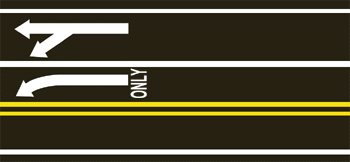
If you are in a lane marked with a curved arrow and the word ONLY, you must turn in the direction of the arrow. If your lane is marked with both a curved and straight arrow, you may either turn or go straight.
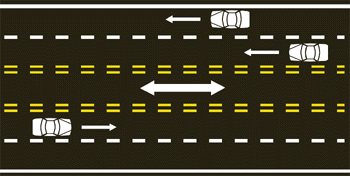
Reversible Lanes
Some highways have reversible traffic lanes to help handle rush-hour traffic. The direction of traffic is normally reversed at set times each day. These pavement markings are used along with special lane signals and other signs and symbols. A solid white line marks the edge of the pavement on most roads. Stop lines, crosswalks and parking spaces are also marked by white lines. Symbols such as arrows are in white also. A single yellow line marks the left edge of all divided or one-way roadways. Curbs are often marked yellow in no parking zones near fire hydrants or intersections. It is unlawful to park in or drive through areas that have pavement markings indicating fire lanes or safety zones.
The lane marking arrow, in the center lane in the diagram, indicates that traffic in this lane can be reversed in accordance with local traffic controls due to "rush hour" traffic or other special traffic conditions.
Drivers from either direction may use the center lane for left turns.
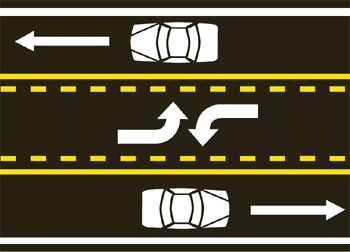
Two-Way Roadway with Center Lane
Two-way roadway with a center lane for left turns in either direction of travel. The specially marked center turn lane is intended for slowing down and for sheltering turning vehicles and may not be used for passing.
Drivers from either direction may use the center lane for left turns.
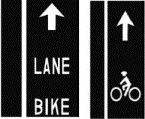 Bicycle Lanes
Bicycle Lanes
Some roads have pavement markings that show lanes specifically designated for the exclusive use of bicycles. Solid or broken white lines separate these bike lanes from motor vehicle travel lanes. You may see bike lanes marked with bike lane signs or by a combination of bicycle symbols and arrows. Where parallel parking is allowed, similar lines may separate the bicycle lanes from the parking lanes.
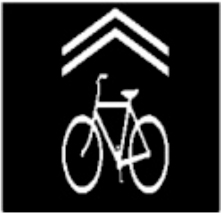 Sharrows
Sharrows
Some roads, mostly in urban areas, do have shared-use lane markings (sharrows).
These markings alert motorists that bicyclists may be on the road; indicate to bicyclists where to ride, and discourage bicycling in the wrong direction.
TEST YOUR KNOWLEDGE
- What does a red traffic light mean? What does a flashing red traffic light mean? (See section 9.1)
- After a full stop at a red traffic light may a driver turn right if the way is clear? (See section 9.1)
- What does a green arrow showing at the same time as a red traffic light mean you can do? (See section 9.1)
- Can you proceed with caution when you approach a flashing yellow light? (See section 9.1)
- If more than one vehicle is approaching a four-way stop sign and you are the first one to get there and stop, do you have the right to move forward first? (See section 9.4)
- Where do you usually find "YIELD RIGHT-OF-WAY" signs posted? (See section 9.4)
- What does a solid yellow line to the right of the center line of the highway mean? (See section 9.6)
- What does a double solid yellow line in the center of the highway mean? What does a double solid white line in the center of the highway mean? (See section 9.6)
- What does a broken white line on the highway mean? (See section 9.6)
Check out our Customer Reviews!


